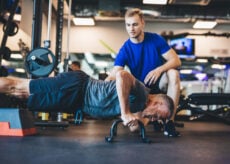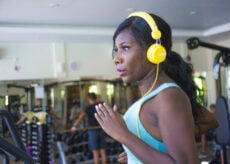30-Day At-Home Workout Program (get fit at home)

Not everyone has 24/7 access to a fully equipped gym, and some folks choose to get their exercise done at home for convenience, privacy, or just because the prefer to fully control the music or atmosphere. Even if you love your gym, there are times when you just need to improvise to get your workout done. This is where a 30-¬day at-¬home workout can come in extremely handy.
Real Results Require Real Commitment
First of all, if you truly want to make progress over the next 30 days while working out at home, it’s going to take some real dedication and commitment. In fact, it may actually take more of a commitment and fitness mindset than you would normally need to keep yourself motivated and on point. Since being at home all day typically means less movement for most folks, staying active every day is key.
If you’re up for the challenge, you’re ready to commit, and you think you have what it takes, then this is the 30-day at-home workout plan for you!
30-Day At-Home Workout Program: The Basics
This plan requires quite a lot of activity, since if you’re mostly sitting around at home, you’re most likely burning off a lot less calories (and moving about significantly less) than you would on a normal day when you’re out and about. Therefore, you’ll start off with three cardio sessions during the first week, coupled with a bit of resistance training. Each week, you’ll either add more activity or increase the intensity of your workout so you can progressively get fit, tone up, and even strip off some body fat over the next 30 days.
** NOTE: Exercises are listed below. Feel free to choose from the list or create your own. There are myriad variations, so don’t be shy about getting creative!
Week 1 At-Home Workout Schedule
During week one, you’ll be doing two full-body resistance training workouts coupled with three cardio sessions. As an example: aim for a full-body workout on Tuesday and Thursday. You can do your cardio sessions on Monday, Wednesday, and Friday, leaving Saturday and Sunday as full rest days. (Your resistance training and cardio workout options are listed below. Pick one resistance training exercise for each body part and repeat 15 – 20 times).
Week 1 Cardio:
Do a five-minute warmup like a slow leisurely walk to prepare for 30 minutes of steady-state cardio (steady-state means you start with a 5-minute warmup to get yourself ready for 25 minutes of a continuous, somewhat brisk aerobic workout).
For Week 1, it’s acceptable to choose something relatively easy like a brisk walk for your cardio sessions, unless you’ve already been working out for a while and you feel you’re ready to progress faster. If so, start with the cardio assignment for Week 2.
Week 2 At-Home Workout Schedule
During Week 2, you’ll be doing three full-body workouts and three cardio sessions. Yes, you’ll be ramping up to six days a week, but remember, you really want to get this fitness thing handled, right?! For your resistance training, aim for 2 sets of the exercises you pick, again with 15 – 20 repetitions for each one.
Week 2 Cardio—Workouts One and Three:
- 5-minute warmup
- 30-minute brisk walk
- 5-minute cooldown
Week 2 Cardio – Workout Two:
- 5-minute warmup
- 20 minutes HIIT cardio
- 5-minute cooldown
Your cardio sessions will consist of a longer steady-state session (like a walk) on your first and last cardio session of the week with a HIIT (high-intensity interval training) workout for your mid-week session. (“HIIT” stands for “high-intensity interval training” and is a short workout where you engage in quick bursts of all-out effort (like 15 seconds) followed by a longer period of slower activity (like 45 seconds to a minute and a half). This is repeated a certain number of times and is preceded by a warmup and followed by a cooldown.)
Here’s an example:
- Monday, Wednesday, Friday – full-body resistance training
- Tuesday – 30 minutes steady-state cardio (walk)
- Thursday – 20 minutes HIIT cardio
- Saturday – 30 minutes steady-state cardio (walk)
Week 3 At-Home Workout Schedule
Week 3, you’ll be doing two upper body and two lower-body training sessions and two 20-minute HIIT cardio sessions. For the upper body, pick two exercises for each of the following and do 15 repetitions for two sets each:
UPPER BODY:
- Chest, Shoulders, and Triceps
- Back and Biceps
LOWER BODY:
- Legs, Calves, Abs
Here’s an example:
- Monday, Thursday – Upper body
- Tuesday, Saturday – 20 minutes HIIT
- Tuesday, Friday – Lower body
Week 4 At-Home Workout Schedule
During Week 4, you should be feeling pretty fit and ready to challenge yourself. Finish strong by doing what’s known as “body part splits” interspersed with steady-state and HIIT cardio workouts. You’ll choose 2 – 3 exercises per body part and perform 10 – 12 repetitions for each exercise for 3 sets. They will go like this:
- Monday: Chest, Shoulders, and Triceps plus 20 minutes of steady-state cardio after your resistance training
- Tuesday: 20 minutes HIIT Cardio
- Wednesday: Back and Biceps plus 20 minutes of steady-state cardio after your resistance training
- Thursday: 20 minutes HIIT Cardio
- Friday: Legs, Abs, and Calves plus 20 minutes of steady-state cardio after your resistance training
- Saturday or Sunday (have one full day of rest): 20 minutes HIIT Cardio

Now that you know how your workout will come together, it’s time to look at what they’re made up of (i.e., the exercises you’ll do). Depending on the week, you’ll choose one to three exercises for each body part. And remember you want to continually push yourself, so if you can perform all of the repetitions for each set plus a few more, it’s time to increase your weight.
Resistance Workouts For Your At-Home Workout Program
Chest Workouts
Pushups—this well-known exercise will work most of your upper body, and you’ll find your arms looking more toned alongside your chest muscles. Start in a “plank” position on your toes, with your legs, hips, and back in a straight line. Your arms should be straight and shoulder-width apart with your palms down. Next, keeping your body straight, bend your elbows and lower your body toward the ground. When your chest is close to the ground, push back up through your arms until they are straight again and pause. Repeat.
If you can’t do a regular pushup, try beginning with your knees on the ground (instead of straight legs) until you can build up enough strength to do a regular pushup.
Dumbbell Presses—lie flat on your back on a bench or the floor with your arms straight out and above you with a dumbbell in each hand. (You can also use a resistance band, a water bottle, soup can, or any other household item that can double as a dumbbell.) With your elbows tracking out toward the sides, bend your arms at the elbows to lower the weight until your upper arms are parallel with the floor, and the dumbbells are at chest level. Pause and push the weight back up to the start position while squeezing your chest muscles.
Dumbbell Flyes—lie flat on a bench or the floor. Grasp a dumbbell (or whatever you’re using for a dumbbell) in each hand and begin with your arms out straight over your chest. The ends of the dumbbells should be touching each other with your palms facing each other. Keeping a slight bend in the elbows, slowly let your arms drop out to your sides until they are parallel with the ground. Raise the dumbbells back to touch in the center over your chest and repeat.
Shoulder Workouts
Shoulder Circles—start with your feet hip-width apart, standing straight. Raise your arms out to your sides until they are parallel with the ground. Next, move your arms in small circles for 20 repetitions. Start by going forward first and then repeat in the opposite direction for 20 more repetitions.
Shoulder Overhead Presses—sit on an upright bench or a chair with your palms facing forward and the weight at ear height. Press the weight upward at a slight angle so the weights come together at the top of the movement when your arms are fully extended. Lower the weights back to the starting position by bending at the elbows and bringing your hands back down to ear level and repeat.
Side Lateral Raises—begin by standing with your feet hip-width apart, with a dumbbell (or household “weight”) in each hand, palms facing the sides of your hips. Bend your elbows slightly and raise your arms directly out to the sides until they are parallel with the floor. Hold for a moment and then slowly lower to the start position and repeat.
Triceps Workouts
Dips—using the edge of a stable chair, sit with your hands wrapped around the edge of the chair and close to your hips. Scoot your hips forward until they drop off the edge of the seat. In a controlled manner, lower your body down toward the ground by bending at the elbows until your upper arms are parallel with the floor. Pause and push your body back up by straightening your arms until you’re back to the starting position.
Dumbbell Kickbacks—begin by kneeling with one knee on a bench or chair and your other leg straightened. You should have a dumbbell or household weight in one hand with your other arm straight, palm down on the bench for balance. Straighten your right arm all the way back while keeping your elbow tucked into your side. When your arm is fully straight, squeeze your triceps at the top before returning to the start by bending your arm again. Repeat for a set number of repetitions and repeat on the opposite side.
Back Workouts
Supermans—lie face down on the ground with your arms and legs stretched out. Your arms will be straight above your head with your hands flat on the ground. Next, lift your arms and legs simultaneously into the air by squeezing all the muscles in your back and posterior chain. Hold this position for 10 seconds and return to the start.
Pullups—if you happen to have a pullup bar or have access to one, these are fantastic basic muscle-building movements to include in your routine. If you need assistance, you can use a rubber or resistance band wrapped around the bar. Make sure the band is in great shape and doesn’t have any tears or discolorations, which could lead to it snapping while you’re working out. Avoid bouncing or “kipping,” which reduces the effectiveness of the exercise. Go for a slow, controlled movement.
Biceps Workouts
Biceps—stand with your feet about hip-width apart and hold a dumbbell (or a household weight or resistance band if you don’t have dumbbells handy) in each hand with your arm straight down next to your hips, palms forward. Bend your arms and lift the weight toward your shoulders. Pause when your biceps are fully contracted and then slowly lower the weight back to the starting point.
Concentration Curl—begin by sitting on the edge of a chair with a dumbbell (or household weight) in your right hand, palm up, and your elbow on your thigh. Start with your arm in front of you and lower the weight toward the floor until your arm is straight. Lift the weight to return to the start position and repeat until you complete your full set. Repeat on the opposite side.
Legs & Lower Body Workouts
Body Squats—these are a fantastic at-home lower-body shaping movement. Start by standing with your feet hip-width apart. With your hands on your hips, bend at the knees and push your hips backward as you squat down toward the floor. Pause when your thighs are parallel with the ground. Push back up through your heels to return to the starting position.
Single-Leg Deadlift—you can perform this exercise with a dumbbell, kettlebell, or try using a full gallon water jug. Begin by standing with your feet hip-width apart. While grasping the weight in your right hand, lift your left leg and stretch it straight out behind you as you lean forward, hinging at the hips. Keep your core straight and bend only at the hips. Once you are parallel with the ground, hold for a moment, and then return to the starting position. Perform ten repetitions and then repeat on the opposite side.
Walking Lunge—start with your hands on your hips and feet about hip-width apart. Step forward with your right leg and bend both knees until they reach a 90-degree angle. Propel yourself forward and back to a standing position by pushing up through your right heel and squeezing your glute muscles. Repeat on the opposite side.
Calves—with (or without) a weight in each hand, rise up onto your toes and stay elevated for a count of 10 and then lower. Repeat three times for one full set.
Abs Workouts
Plank—start by lying face down on the ground and lift your body onto your toes and your forearms. Your forearms should be about shoulder-width apart with your elbows directly under your shoulders. Keep your body in a straight line and hold this position for 30 seconds at a time. You may work your way up to longer periods of time as you get stronger. Place your knees on the ground to rest in-between sets.
Crunches—lie on your back with your knees bent and feet flat on the floor. Next, press your lower back into the floor as you raise your torso off the ground and toward your knees. Keep your back straight (not rounded), and do not pull your head forward at the neck. Hold in the contracted position for a moment before returning to the start and repeat.
Leg Lifts—lie on your back with your legs straight and your arms next to your sides, palms down. Tighten your abdominals and raise your legs toward the ceiling while keeping them straight. Lower slowly to the start and repeat.
Outdoor Cardio Ideas
Run the stairs—if you’re near a school or college stadium, you may be able to run the stairs. You can also try taking them two at a time and then gently jog back down to start and repeat.
Park equipment—many parks offer circuit-training equipment along some of their paths. Check out the pullup bars, climbing walls, and balance beams as you walk or jog through the park.
Jumping Jacks—begin by standing with your arms by your sides and your feet together. Next, jump up and spread your feet out, so they land about a foot apart while simultaneously bringing your arms straight out to the sides and up. Your second jump will bring your feet back together and your arms back down by your sides. This is one complete jumping jack.
Step-Ups—step-ups really help to activate the glutes but are also wonderful for cardio. Stand in front of a stable step or bench. With your feet hip-width apart, take your right leg and step up onto the platform. Push through your left heel and squeeze your glutes to lift your body up onto the step while straightening your leg. Step back down slowly with your right foot and repeat on the opposite side.
Jump Squat—jump up in the air, and upon landing, bend your knees to do a body squat. Pause at the bottom and then shoot back up into a jump. Repeat for 20 seconds as fast as you can and then rest for two minutes.
Running in Place—begin by alternating lifting and bringing your knees up to navel level. Continue picking up speed until you are running in place. Continue for 30 seconds.
If you can’t make it to your favorite gym for any reason, that’s not an excuse to miss your workout and all the fantastic benefits of exercise. Just grab your workout gear, your water bottle, and find some space to move around (indoors or out).





 7 Signs Your Body is Seriously Low on Collagen (not just wrinkles)
7 Signs Your Body is Seriously Low on Collagen (not just wrinkles) Health Expert: "Turmeric Doesn't Work (unless...)"
Health Expert: "Turmeric Doesn't Work (unless...)" 3 Warning Signs Your Probiotic Supplement is a Total Waste
3 Warning Signs Your Probiotic Supplement is a Total Waste

